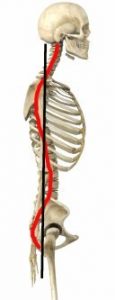Thoracic Spine Mobility:
To keep you upright, the spine is constantly attempting to find it’s vertical center of mass. So, in order to keep this center of mass constant, if the curvature in area of the spine increases, it is very likely that you will see an increased curvature somewhere else along the spine to counter balance and keep you upright.In the first figure, you see a natural spine with a normal cervical curve (neck) in slight extension, then a soft thoracic spine curvature the opposite direction, then down to a natural lumbar curve, which is in extension, and finally at the bottom, there is another curve back the opposite direction at the sacrum. The vertical line depicts the vertical center of mass which the body is constantly seeking.
If at any point (i.e. the Thoracic Spine) the curvature is increased, the parts of the spine above and below it will increase their curvature as well. As depicted in the second graphic, a decrease in Thoracic Spine extension (kyphosis), will lead to an increase in lumbar and cervical extension. This over exageration of the curvature in these areas will undoubtedly cause pain and injury in one or both of these areas.
Because of this balancing act, addressing the Thoracic Spine should be an important part of any treatment plan for low back pain and/or neck pain.
Do you have back pain and unsure how to fix it? Here is your solution…
Learn more about how the Thoracic Spine affects other movements:
Learn about mobility of the T-Spine:
Looking for more help? Schedule a consultation today!
Back to Thoracic Spine MobilityBack to Injury Rehabilitation
Back to Home




Leave a Reply